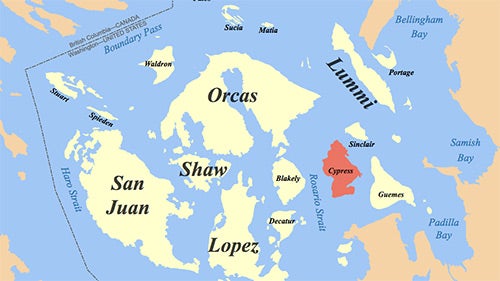(Editor’s note: This post about the Atlantic salmon escape first appeared in a longer form on the SeaDoc Society website.)
On Aug. 19 and 20, a net pen owned by Cooke Aquaculture Pacific collapsed, releasing an undetermined number (estimates range from 4,000 to 185,000) of the 305,000 Atlantic salmon being raised there into the waters around Cypress Island, just northwest of Anacortes, Washington.
In a region where vast amounts of money and effort have been spent attempting to restore wild salmon runs, this mass escape of non-native fish has caused a public uproar. How could this happen? Will the Atlantic salmon spread disease to wild fish? Will they outcompete native salmon for food or freshwater spawning habitat?
To try and answer the questions, it’s valuable to look at the established science. Unfortunately, salmon spills like this are not new events in the Pacific Northwest.

Farmed fish escape from sea pens
People have been farming Atlantic salmon in Washington since 1982, and in British Columbia since 1985. Despite assurances from the aquaculture industry, wherever fish are farmed in sea pens there are escapes.
In fact, on July 2, 1996, high tidal flows destroyed seven net pens at an Atlantic salmon farm near Cypress Island, releasing or killing 101,000 Atlantic salmon. Sound familiar? The lessons from that and other releases should inform us about the risk that farmed Atlantic salmon pose for the Salish Sea’s five species of native salmon.
Concern about transmitting disease to wild salmon
The first concern is the potential for released farmed salmon to transmit disease to wild salmon. Farmed Atlantic salmon can carry viruses, bacteria and parasites like sea lice that can infect wild salmon. The release of thousands of salmon that were actively experiencing a disease outbreak could have huge ramifications for wild salmon.
In Washington State, all public and private growers of salmon, including Atlantic salmon hatchery operators, are required to adhere to strict disease control polices.
While we have not seen data on the health or disease status of the released Atlantic salmon, it was reported that they were treated for a bacterial infection called yellow mouth in July 2016 but were believed to be disease-free at the time they escaped.
Without detailed disease testing data, it is difficult to know what the potential for disease transmission could be in this most recent release. An evaluation of the risk of disease transmission from farmed Atlantic salmon to wild Pacific salmon conducted over a decade ago classified the risk as low due to existing disease testing protocols and the state’s prohibition of bringing new Atlantic salmon stocks or eggs into Washington (which limits new diseases from entering).
Native salmon vs. farmed fish for food and breeding
As to whether released farmed salmon will compete with native salmon for food and breeding or spawning space, studies have shown that while their performance and reproductive success in nature vary, farmed Atlantic salmon often are outcompeted by wild salmon of similar size.
Researchers and volunteers from the non-profit KWIAHT (Center for the Historical Ecology of the Salish Sea) dissected 31 Atlantic salmon caught in Watmough Bight in late August and found empty stomachs with the exception of two fish that each had one small mussel shell and a few crumbs of fish chow pellets. This suggests that while released farmed Atlantic salmon will compete with wild salmon for food, many also don’t make the transition from being fed pellets in farms to catching and eating wild food.
For those that do, though, stonefly nymphs found in the stomachs of Atlantic salmon caught in the Salmon River (Vancouver Island) suggest that escaped Atlantic salmon also can be predators in freshwater as well as in ocean.
Farmed fish can be easy prey for seals and sea lions
The only potential positive from this large release of Atlantic salmon is that these farm-raised fish should serve as easy prey for seals, sea lions and eagles, maybe taking some predation pressure off wild salmon.
On balance, though, the science looking at past net pen releases of Atlantic salmon in this region suggests that there can be negative impacts to native salmon including disease transmission, competition for food and breeding habitat, and the potential for long-term establishment of an introduced Atlantic salmon run.
The message from the public appears clear: With the billions of dollars we’ve invested to protect and recover native wild Pacific salmon, any introduced risk like farmed Atlantic salmon is unacceptable.
Read more about native salmon problems in the Pacific Northwest in our blog post “4 Struggling Marine Species Helped by SeaDoc Scientists.”
Veterinarian Joe Gaydos is science director for the SeaDoc Society, a program of the UC Davis Karen C. Drayer Wildlife Health Center and based on Orcas Island, that focuses on finding science-based solutions for preserving the health of marine animals in the area known as the Salish Sea.